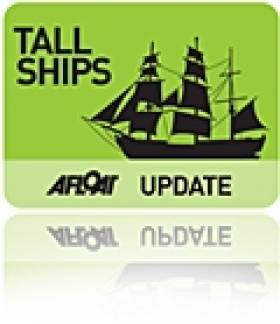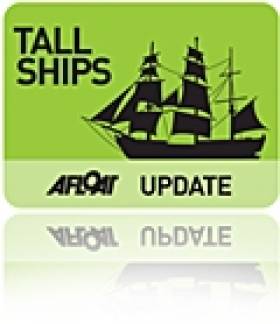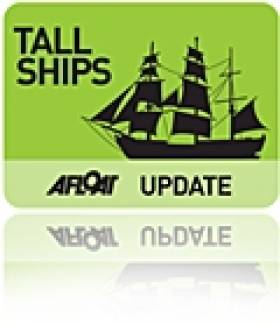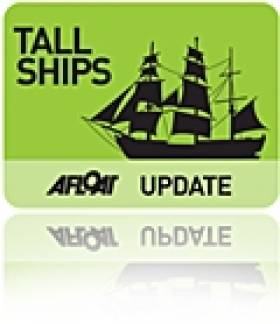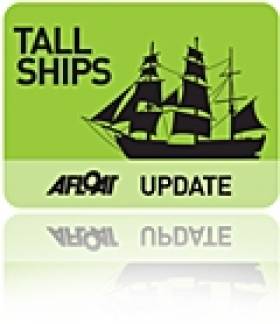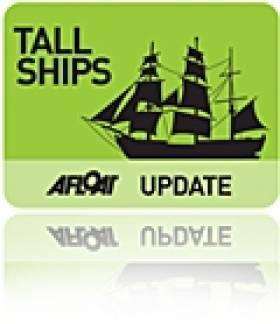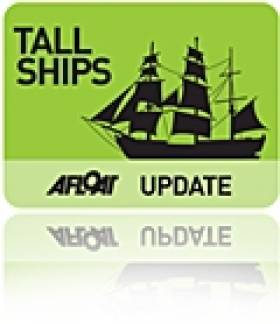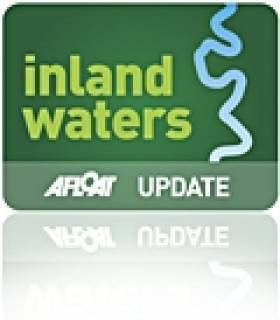Displaying items by tag: Waterford
The Celtic Mist, the new flagship of the Irish Whale and Dolphin Group, was berthed in Waterford city for the Tall Ships weekend writes Shay Fennelly. Gifted to the IWDG in May 2011 by the family of a former Irish Prime Minister, Charles Haughey, who declared Irish waters a whale and dolphin sanctuary in 1991.
Celtic Mist left Waterford on Sunday morning in glorious sunshine on passage down the River Suir for the Tall Ships Parade of Sail off Dunmore East watched by thousands of people from the river bank at Passage east, Duncannon and Dunmore East.
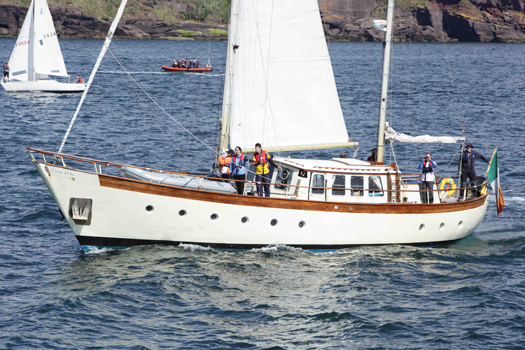
Ireland's only entry in the 2011 Tall Ships race from Waterford to Greenock Irish Whale and Dolphin Groups's research vessel Celtic Mist in the Tall Ships Parade of Sail off Dunmore East in Waterford. Photo: Shay Fennelly/Aquaphoto
The Tall Ships fleet was reviewed by Flag Officer Commanding Naval Service Commodore Mark Mellet and Sean Flood Sail Training Ireland (Board) and a Goodwill Ambassador for Sail Training International past the LE Aoife. Over 1200 young people, many who have never been to sea before, are onboard the 50 tall Ships sailing to Greenock.
On board Celtic Mist are Captain Fiacc Brolchain, Gary Davis, Eithne Griffith, Deirdre Slevin, Conor Ryan and trainees Siobhan Ardener (19) from Killarney, Co Kerry, and Keith Cleere (19) from New Ross, Co Wexford.
The race started slowly at 15.00hrs, five miles south of the Hook Lighthouse in 10 knots of wind and blue skies and headed for the Irish Sea to Scotland.
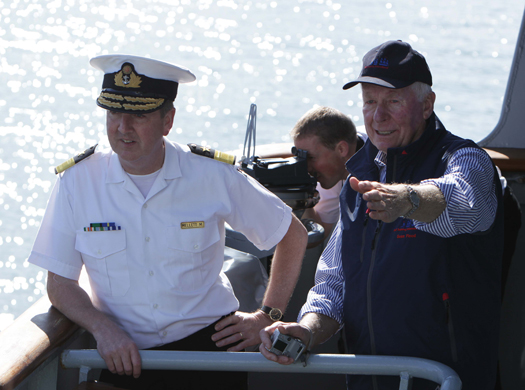
Flag Officer Commanding Naval Service, Commodore Mark Mellet (left) and Sean Flood Sail Training Ireland (Board) and a Goodwill Ambassador for Sail Training International on board LE Aoife reviewing the Tall Ships fleet as they passed off Dunmore East, County Waterford. Photo: Shay Fennelly/Aquaphoto
Famine Ship Needs €100K to Get Seaworthy
The Jeanie Johnston will need €100,000 to be made seaworthy again, it has emerged.
The three-masted barque - which not long ago sailed across the Atlantic - was missed at the weekend's Tall Ships festival, which attracted half a million visitors to Waterford.
But as the Sunday Independent reports, the ship is currently a stationary tourist attraction at berth in Dublin with her sails in storage.
Hopes are high, however, that the replica famine ship will be made ready as an ocean-going vessel in time for the Volvo Ocean Race in Galway next summer, not to mention the Tall Ships Races in Dublin next August.
"At the moment we are basically putting all the money coming in from the interactive tours, which have been very successful, back into the boat," said ship manager John O'Neill. "We are hopeful we will get the financial assistance we need to get the vessel back out to sea".
Tall Ships Parade of Sail Photos 2
More of Gary O'Mahony's images of the Tall Ships fleet leaving Waterford.
Waterford Tall Ships Parade of Sail Photos
Thousands bade farewell to the 45 tall ships departing Waterford this afternoon. Afloat Photographer Gary O'Mahony captured the scene. Scroll down for the photos.
Dunmore East Bids TallShips Farewell
As the Russian 'A' class Mir passed the LE Aoife off Dunmore East in mid-morning, the largest tall ship of the festival headed the start of the Parade of Sail, writes Jehan Ashmore.
Crowds left their cars in fields outside Dunmore East and descended into the harbour and surrounding headlands to witness the highlight of the four-day festival. Adding to the scene were the numerous leisure-craft, yachts and intrepid kayakers that gathered to greet the procession which took some two hours to pass the fishing harbour.
No sooner had the fully-rigged ship Mir had slipped beyond the anchored naval vessel that the gaff schooner Johanna Lucretia, under full sail came closer into view. She was closely followed by the Ocean Youth Trust Scotland's Bermudan cutter Alba Explorer.

The Russian 'A' class Mir passing the LE Aoife off Dunmore East. Photo: Jehan Ashmore
Of all the 45 tallships participating the Columbian Navy's barque ARC Gloria presented the most colourful entrant. She proudly flew a large horizontal tricolor of yellow, blue and red representing the South American nation.
When it came to the turn of the Europa to pass the LE Aoife, the tug Bargarth gave a wonderful send-off with the traditional display of water jets shooting sky-high, nearly reaching the top of the three-masted barque.
Marking the tail-end of the parade was the Jubilee Sailing Trust's Lord Nelson, another barque that departed the estuary with the Hook Head Lighthouse forming a majestic backdrop.
At this stage several of the large tallships could be seen on the far horizon in preperation to the start of the first race leg of this years Tall Ships Races....next port of call Greenock!
- Waterford
- ship
- Dunmore East
- Lord Nelson
- Waterford Estuary
- LE Aoife
- Sail Training International
- Jubilee Sailing Trust
- Tug
- Hook Head
- Tall
- JOHANNA LUCRETIA
- TallShips
- Waterford Harbour
- JST
- Europa
- Fullyrigged ship
- STI
- ARC Gloria
- Hook Head Lighthouse
- Mir
- Gaff schooner
- Ocean Youth Trust Scotland
- Bermudan cutter
- Alba Explorer
- Columbian Navy barque
- Bargarth
- Fastnet Shipping
It's Official: Third Time Tallships for Waterford
Scenes of the tallships moored alongside the north and south quays and the surrounding festivities are captured by Gary O'Mahony. SCROLL DOWN FOR PICS.

The Columbian Navy's Sailing Training Ship ARC Gloria. Photo: Jehan Ashmore
This is the second year in which the city has been the host port of the Tall Ships Race and the prestigious event is to return for a third time. The next occasion has not been confirmed but it would be several years away according to Sail Training International, the organisers of the famous race.
Tall Ships Races Could Mean Big Money for Waterford
This weekend's Tall Ships Races in Waterford could bring in up to €35 million to the local economy, according to Fáilte Ireland.
Gerry Breen of Fáilte Ireland also told The Irish Times that the event would complement the new Viking Triangle development in the city, which is hoped to be a major tourist attraction.
Des Whelan, chairman of the Waterford Tall Ships Race 2011, said the official website had registered nearly 200,000 hits, and hotels in the city are almost completely booked out.
Opening the weekend's festivties this evening are a fashion show on board the Russian sailing ship Mir, and a special concert by Roxy Music singer Bryan Ferry.
The first of three impressive fireworks displays will also light up Waterford's skies at 10.30pm tonight.
The Tall Ships are Here! (Arrival Photos)
After a long wait for the Tall Ships, they're finally sailing in Irish waters again. Photographer Gary O'Mahony captured some of the arrivals into Waterford yesterday.
Hosting of the Tall Ships Race will be worth an estimated €25 to €35 million to the regional economy, with 500,000 visitors expected to attend the four-day festival. More on Tall Ships in Ireland HERE.
Irene of Bridgewater, Pelican of London in the background

John Laing

(Above and below) Sorlandet of Norway


Christian Radich of Norway as it passes Arthurstown
Yacht Towed to Harbour after Collision with Tall Ship
The lifeboat launched at 2.38am and was on scene at 3.32am. Reports had been received from Dublin Coast Guard that the yacht was in urgent need of assistance after being damaged on collision with another vessel and was taking on water.
Arriving on scene the volunteer lifeboat crew saw debris in the water and noticed a considerable amount of damage to the yacht on the port side. They immediately assessed the state of the crew on both vessels, fifteen were onboard the Tall Ship and a single crewmember onboard the yacht.
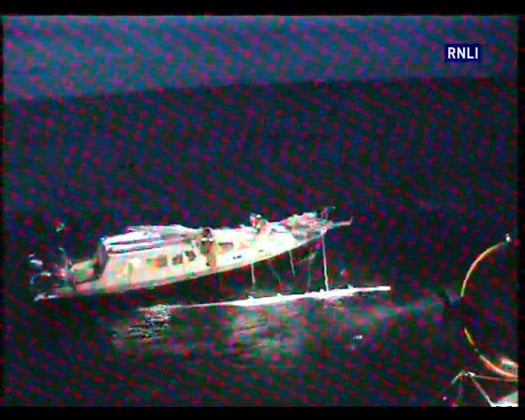
The casualty vessel - Photo: RNLI
On establishing there were no injuries three lifeboat crew boarded the yacht and cleared some of the debris from the water. Due to the damage the lifeboat crew took the yacht under tow back to Rosslare Harbour and the Tall ship made its way on to Waterford.
The Irish Coast Guard Helicopter from Waterford arrived on scene and provided a strong search light overhead for the crews to work in. Conditions were good with a slight swell.
Commenting on the callout, Rosslare Deputy Launching Authority Dave Maloney said, " While there was damage to one of the vessels thankfully there was no serious injury to any person. The priority for the lifeboat crews was to ensure that there was no danger to anyone and that the vessel was taken back to shore as quickly as possible due to the threat of sinking.”
Quay to Unlock Old Memories
Cheekpoint was an important milestone on the barges journey, for it was here that the barges turned onto the Suir for the final leg upriver to the ports of Waterford and Carrick. It was also here that the local Eel Fishermen would often cadge a tow from an upriver barge saving them a long and difficult row in their traditional Prongs. In turn the barge men might enjoy a bit of company, a chat over a brew of the 'kittle' on the Bolinder and perhaps a few fresh fish for the supper. And so a fine co-operative grew up between the bargemen and the fishermen that led to many lasting friendships. It is fitting therefore that Cheekpoint once again acts as host to these unique boats, for they enjoy a shared heritage that deserves to be celebrated by both their crews and the local communities.
This year's journey commenced on a frosty morning in March when 68M headed north on the River Shannon and turned onto the Grand Canal north of Banagher. At the same time 72M quietly slipped her moorings in Naas and led the now growing fleet south onto the River Barrow at Athy. At towns and villages along the waterway, communities celebrated the arrival of the Heritage Boats and the revival of the Barrow Navigation, thanks to the excellent work by the engineers and staff of Waterways Ireland. 2011 is a significant year, marking the 220th anniversary of the opening of the Navigation. Five counties are celebrating with a series of events and festivals taking place all year to mark the occasion.
From the June 27th until the July 3rd, the Heritage Boats will be based at Cheekpoint Quay and a wide range of activities are planned with the local community. This visit will highlight the work of the Friends of Cheekpoint Quay to restore the harbour as the focal point of the village.
The Reading Room in the village will be the venue for a River and Maritime and Heritage Boat Association Exhibition. There will be guided walks in Cheekpoint and Faithlegg Woods, a Village Fete on the Green, the launch of the Newfoundland Dory, a Flotilla of Boats from Cheekpoint to Waterford, a School Art Happening and other events.



























